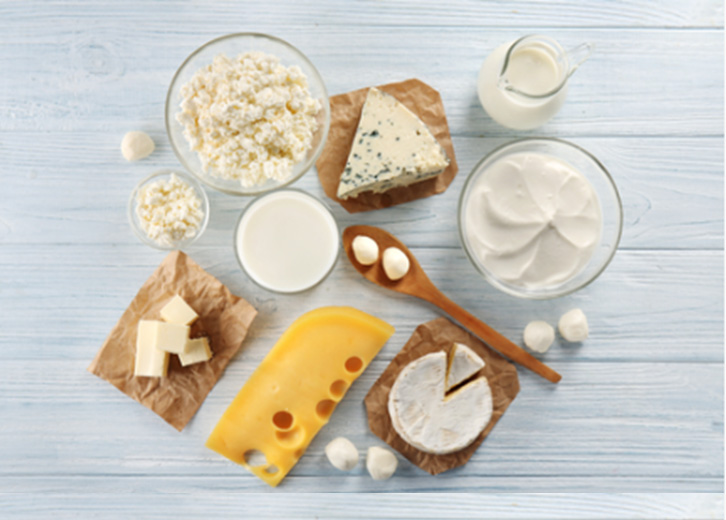Trouble digesting dairy is not really a disorder, it’s just a natural variation in how our digestive system works. Most people in the world have trouble digesting dairy past infancy and symptoms can get worse with age.
Here are some tips and tricks to survive in a dairy filled world.
Learn Your Dairy Vocabulary
Lactose Intolerance
Lactose is a sugar in milk that requires our body to make lactase, a digestive enzyme to breakdown and absorb lactose. About 65% of adults worldwide can’t breakdown and absorb lactose.
Secondary lactose intolerance, which is often caused by damage to your intestines, might be reversible after your small intestine recovers. The damage can be sudden, often caused by radiation therapy, celiac disease, inflammation in colon, small intestinal bacterial overgrowth, infections in the intestines, and other food intolerances.
Dairy allergy
A true allergy to dairy food is rare. These sudden and sometimes extreme reactions are mediated by IgE antibodies, which can be tested for. May need to carry an Epi Pen.
Dairy sensitivity or intolerance (milk protein intolerance)
This is a common intolerance to milk proteins such as casein and whey (as opposed to intolerance to the sugars with lactose intolerance). It can be measured by immune marker IgG.
Symptoms are often gastrointestinal related but can also show up in other body systems such as headaches, fatigue, frequent infections, respiratory problems and more.
For more information about food testing, here’s another BNHC article:
Are Foods Causing Your Symptoms? Understanding Testing Options – Boise Natural Health Clinic
Pareve or Parve
If a label says Pareve or Parve, it is milk-free to conform to Jewish food laws.
Whey, casein, caseinate, lactalbumin, lactose
These are all forms of dairy that are added to foods for flavor or to improve nutritional content.
Ingredients that do not contain dairy (but sound like they do)
Calcium lactate, calcium stearoyl lactylate, cocoa butter, cream of tartar, lactic acid, oleoresin, sodium lactate, sodium stearoyl lactylate.
Hidden Sources of Dairy
Battered fried foods, biscuits, breads, breakfast cereals, cakes, chewing gum, chocolate, cookies, cream sauces, cream soups, custard, deli meat, ghee, gravies, hot dogs, ice cream, imitation sour cream, instant mashed potatoes, malted milk, margarine, muesli, muffins, nougat, packaged soups, paneer, pies, puddings, sausages, sherbet, soy cheese, tuna fish (canned), soup mixes.
Another source: restaurants may put butter on steaks after grilling to add flavor.
Dairy Substitutes
- Dairy free cheese, milk, creamer, sour cream –We are in the hey-day of dairy free products, and they have improved so much in recent years.
- Avocado – the texture and fat make it a great pretend cheese
- Look for the word “vegan” on packaging as an easy way to tell if dairy free.
- The Treasure Valley has some awesome creamy, non-dairy options for ice cream:
https://www.stellaicecream.com/boise
https://www.lovejoysicecream.com/
When You Want to Indulge – some kinds of dairy may be better
People generally do worse on milk, soft cheese, and especially ice cream. However, there is less lactose and you are likely to have less symptoms with drier, aged cheeses (such as parmesan), fermented dairy such as yogurt, and goat or sheep milk products (instead of cow).
If you do have dairy, choose smaller servings and eat with other food to help digestion.
Lactase & Enzyme Supplements
These are tablets or drops you take before consuming lactose that provide the enzyme to break lactose down. Potentially worth a try if you are just lactose intolerant. Won’t help with a dairy protein sensitivity.
We recommend Enzymedica Digest Spectrum which has high-potency enzymes to support digestion of foods containing both gluten and dairy, as well as vegetables and beans. You can shop on your BNHC Fullscript account:
Link to Fullscript – Digest Spectrum Enzymedica
Is Dairy Addictive?
It’s not just cravings, we can get hooked. A protein found in cheese comes from casein which, during digestion, releases casomorphins, a substance chemically similar to opioids. These casomorphins can attach themselves to the same receptors in our brains as heroin and other narcotics resulting in a little hit of dopamine and increased cravings.

